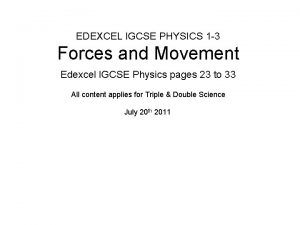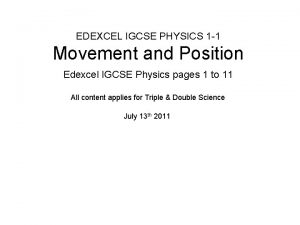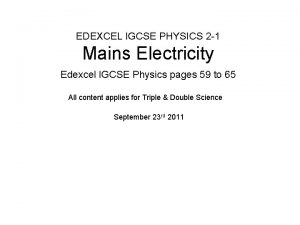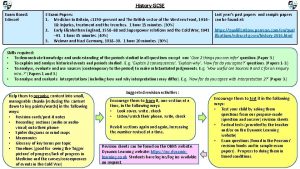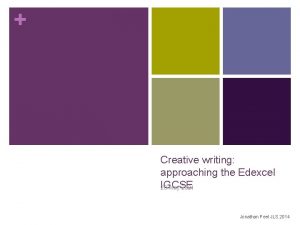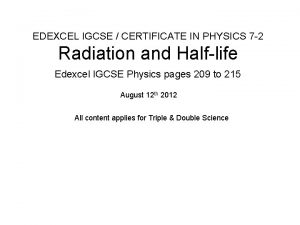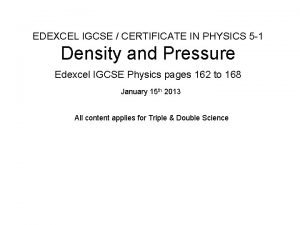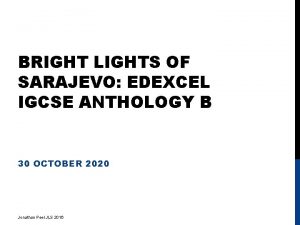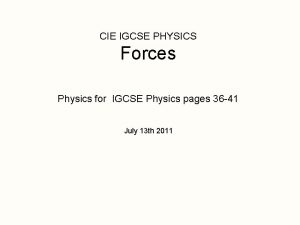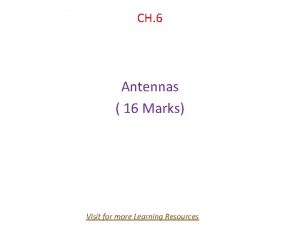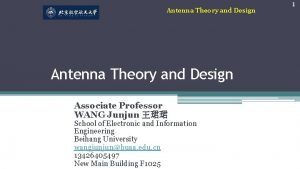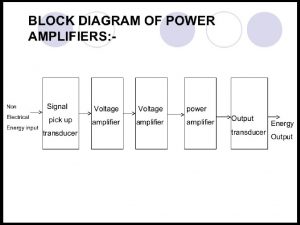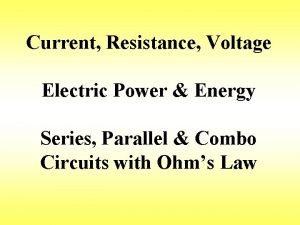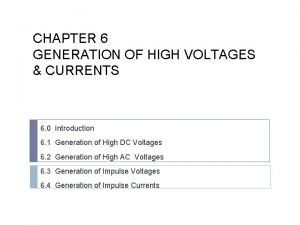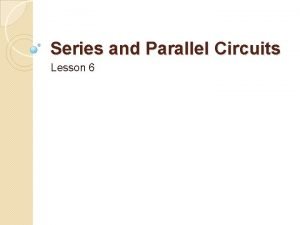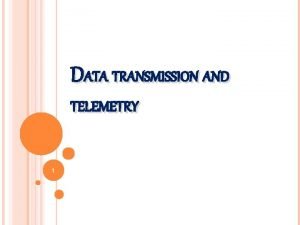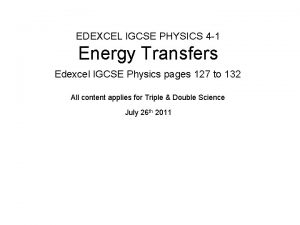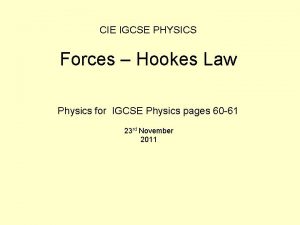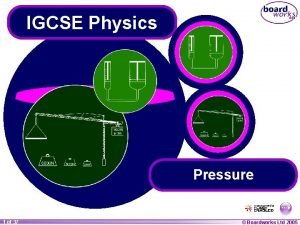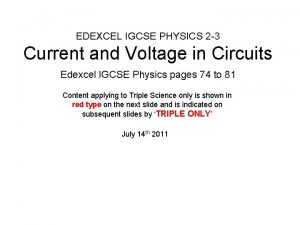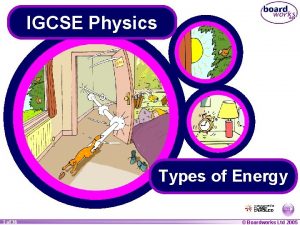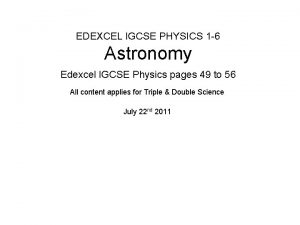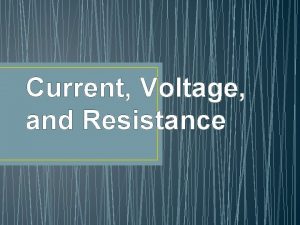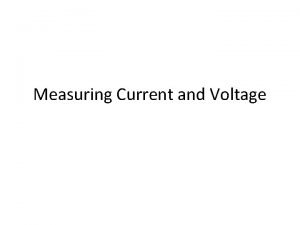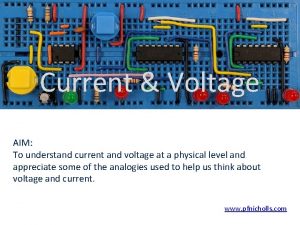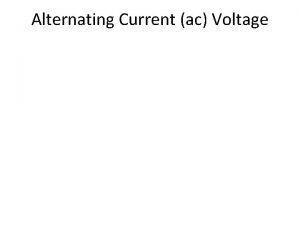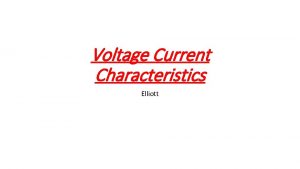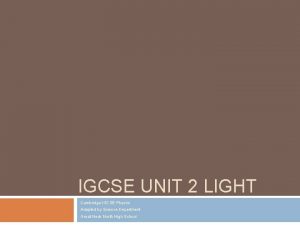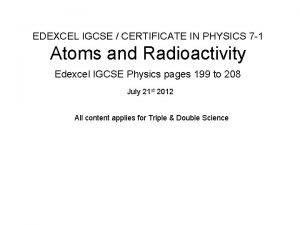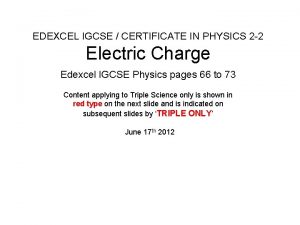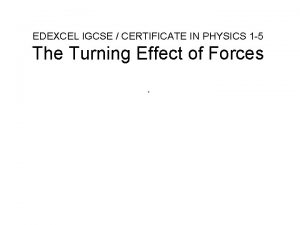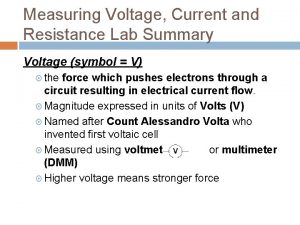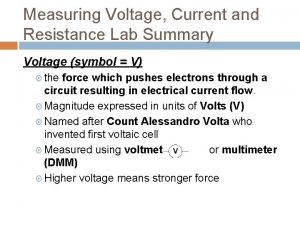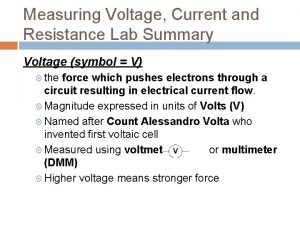EDEXCEL IGCSE PHYSICS 2 3 Current and Voltage
































- Slides: 32

EDEXCEL IGCSE PHYSICS 2 -3 Current and Voltage in Circuits Edexcel IGCSE Physics pages 74 to 81 Content applying to Triple Science only is shown in red type on the next slide and is indicated on subsequent slides by ‘TRIPLE ONLY’ July 14 th 2011

Edexcel IGCSE Specification Section 2: Electricity c) Energy and potential difference in circuits explain why a series or parallel circuit is more appropriate for particular applications, including domestic lighting understand that the current in a series circuit depends on the applied voltage and the number and nature of other components know that lamps and LEDs can be used to indicate the presence of a current in a circuit understand that current is the rate of flow of charge recall and use the relationship: charge = current × time Q = I × t recall that electric current in solid metallic conductors is a flow of negatively charged electrons recall that: • voltage is the energy transferred per unit charge passed • the volt is a joule per coulomb. Red type: Triple Science Only

COVERED UNDER ELECTRIC CHARGE Electrical conductors and insulators An electrical conductor is a material through which electric current flows easily. All metals are conductors. Electrical insulators have a very high resistance to the flow of electric current. Complete the table below: copper rubber steel mercury paper plastic diamond graphite conductor 1 insulator 2 conductor 3 conductor insulator 4 insulator 5 insulator 6 conductor

COVERED UNDER ELECTRIC CHARGE BY TRIPLE GROUPS ONLY Electric charge can be either positive or negative. In an atom an electron has a negative charge that is of the same size as the positive charge of a proton. Neutrons have no electric charge. As an atom has the same number of electrons as protons it is uncharged.

Electric current An electric current is the rate of flow of electric charge. An electric current of one ampere (A) flows when a charge of one coulomb (C) passes a point in an electric circuit in one second In metallic conductors (e. g. copper wire) electrons carry negative charge from the negative side of a power supply, around a circuit and back into the positive side. The arrow shows the direction of electron flow.

Charge-current equation electric charge = current x time Q=Ixt also: I = Q ∕ t and: t = Q ∕ I charge current time

Question 1 Calculate the charge passing through a device when a current of 500 m. A flows for 3 minutes. Q=Ixt = 500 m. A x 3 minutes = 0. 5 A x 180 s charge = 90 C

Question 2 Calculate the current flowing when a charge of 240 C flows through a device in 80 s. I=Q÷t current = 240 C 80 s current = 3 A

Answers Complete: Q I t 60 C 2 A 30 s 65 C 13 A 5 s 960 C 3 A 4 minutes 3 C 50 m. A 60 s

TRIPLE ONLY Voltage A battery gives electrical charge energy. The voltage of a battery is equal to the energy in joules provided when a charge of one coulomb passes through the battery. voltage = energy ÷ charge 1 volt is the same as 1 joule per coulomb

TRIPLE ONLY Question Calculate the voltage of a battery if it supplies 300 joules of energy to 50 C of charge. voltage = energy ÷ charge = 300 J 50 C battery voltage = 6 V

TRIPLE ONLY Answers Complete: Voltage Energy Charge 12 V 480 J 40 C 20 V 500 J 25 C 6 V 120 J 20 C 230 V 69 k. J 300 C

TRIPLE ONLY Choose appropriate words to fill in the gaps below: charge Electric current is the rate of flow of electric _______. coulombs Electric charge is measured in _____. energy. The amount of energy A battery provides electrical _______ coulomb of electric charge passing is equal to provided per _____ voltage the ____ of the battery. joules mains The _______ supply gives 230 ____ to every coulomb of charge. WORD SELECTION: coulombs charge mains joules coulomb voltage energy

Electric circuits An electric current will only flow if there is a complete, unbroken electric circuit, that contains a power supply. A circuit diagram uses a standard set of symbols to show electrical components are connected together.

Circuit symbols cell a cell is required to push electrons around a circuit battery a battery consists of two or more cells wires should always been drawn as straight lines wire junction switch a switch enables the current in a circuit to be turned on or off

indicator often a light bulb – this is used to show whether or not a circuit is on light bulb old symbol – the indicator symbol is now used A ammeter measures electric current in amperes (A) V voltmeter measures voltage in volts (V)

fixed resistor a resistor is used to limit the current in a circuit variable resistor thermistor a device whose resistance decreases with temperature light dependent resistor (LDR) a device whose resistance decreases with brightness

diode a diode only allows current to flow in one direction (indicated by the arrow) light emitting diode (LED) fuse a diode that emits light when it allows the flow of electric current a fuse is designed to melt and so break an electric circuit when too much electric current flows heater a device used to convert electrical energy to heat

Electric current flows from the POSITIVE terminal of a power supply around a circuit to the NEGATIVE terminal. The longer thinner line of the symbol for a cell is the positive terminal. In the circuit above the diode is aligned so that it allows current to flow through the radio.

Complete symbol component A ammeter symbol component heater diode resistor indicator thermistor cell LDR

Question Draw a circuit diagram for the torch shown below.

Series circuits Circuit components are said to be connected in series if the same electric current passes through each of them in turn. 3 A 3 A The cell and the two lamps are in series with each other and so the same electric current passes through all of them.

In a series circuit all of the components can be controlled by using just one switch. Each component shares the voltage of the power supply and so adding more bulbs in series will cause each bulb to become dimmer.

Parallel circuits The voltage across each component connected in parallel is the same. The voltmeter reading for component X, V 1 will be the same as the voltmeter reading for component Y, V 2.

In a parallel circuit all of the components can be individually controlled by using separate switches. If one light bulb blows the other bulbs will still carry on working.

Currents in parallel circuits The total current through the whole circuit is the sum of the currents through the separate components. 5 A 5 A 3 A 2 A

What are the advantages of connecting two lamps in parallel rather than in series to a power supply? When connected in parallel: 1. the lamps are brighter than when connected in series 2. the lamps can be controlled individually with switches 3. one lamp will continue working even if the other does not

Calculate the currents measured by ammeters A 1, A 2 and A 3 in the circuit below. 6 A A 3 A 1 A 2 A 1 = 2 A A 2 = 4 A 2 A A 3 = 6 A

Choose appropriate words to fill in the gaps below: connected together in series they will When components are _____ current flowing through each of them. all have the same _____ When components are connected in parallel to each other voltage they will each have the same _____. parallel Lamps are usually connected in _____ to each other as switches this allows them to be controlled individually by _____ blows the others can still continue to and if one lamp _______ operate. WORD SELECTION: blows current switches parallel connected voltage

Online Simulations Fifty-Fifty Game on Conductors & Insulators - by KT - Microsoft WORD Signal Circuit - Ph. ET - Why do the lights turn on in a room as soon as you flip a switch? Flip the switch and electrons slowly creep along a wire. The light turns on when the signal reaches it. Charge flow with resistors in series and parallel NTNU Circuit Construction DC Only - Ph. ET - An electronics kit in your computer! Build circuits with resistors, light bulbs, batteries, and switches. Take measurements with the realistic ammeter and voltmeter. View the circuit as a schematic diagram, or switch to a life-like view. Simple parallel circuit with motor and lamps Freezeway. com Simple parallel circuit with motor and lamps and a short circuiting switch - Freezeway. com Switch quiz circuit - Freezeway. com Two way switches with a flight of stairs Freezeway. com Bulb circuit diagram quiz - Freezeway. com Hidden Pairs Game Circuit Pairs Quiz basic circuit symbols with this pairs game - by e. Chalk Hidden Pairs Game on Circuit Symbols - by KT Microsoft WORD Electric Current Quizes - by KT - Microsoft WORD BBC KS 3 Bitesize Revision: Circuit symbols Series and parallel circuits Measuring current and voltage Current in series circuits BBC AQA GCSE Bitesize Revision: Circuit symbols & diagrams Series & parallel connection Current & potential difference Cells and circuits Series circuits Parallel circuits

TRIPLE ONLY Current and Voltage in Circuits Notes questions from pages 74 to 81 1. 2. 3. 4. 5. 6. 7. 8. Describe how electric current flows through a metallic conductor. (see pages 75 and 75) (a) State the equation in words and symbol form relating electric current to charge. (b) Calculate the charge that flows when a current of 5 A flows for 40 seconds. (a) What is meant by voltage? (b) How much energy will a 12 V battery supply to a charge of 4 coulombs? Draw the circuit symbols for: (a) battery; (b) diode; (c) bulb; (d) fuse; (e) variable resistor; (f) LDR; (g) thermistor. (see page 77) List the differences between series and parallel circuit connection. Give an advantage for each case. (see pages 77 to 79) Why are LEDs used in preference to light bulbs? Answer the questions on pages 80 and 81. Verify that you can do all of the items listed in the end of chapter checklist on page 80.

DOUBLE ONLY Current and Voltage in Circuits Notes questions from pages 74 to 81 1. 5. Describe how electric current flows through a metallic conductor. (see pages 75 and 75) (a) State the equation in words and symbol form relating electric current to charge. (b) Calculate the charge that flows when a current of 5 A flows for 40 seconds. Draw the circuit symbols for: (a) battery; (b) diode; (c) bulb; (d) fuse; (e) variable resistor; (f) LDR; (g) thermistor. (see page 77) List the differences between series and parallel circuit connection. Give an advantage for each case. (see pages 77 to 79) Why are LEDs used in preference to light bulbs? 6. Answer questions 1, 2, 4 and 5 on pages 80 and 81. 2. 3. 4.
 Edexcel igcse physics forces and motion questions
Edexcel igcse physics forces and motion questions Distance time graph for uniform motion
Distance time graph for uniform motion Electricity igcse physics edexcel
Electricity igcse physics edexcel Young and dyslexic poem
Young and dyslexic poem Young and dyslexic poem
Young and dyslexic poem Edexcel gcse history past papers
Edexcel gcse history past papers Edexcel igcse computer science
Edexcel igcse computer science Gcse edexcel english literature
Gcse edexcel english literature Imaginative writing edexcel igcse
Imaginative writing edexcel igcse Igcse certificate edexcel
Igcse certificate edexcel Physics and maths tutor density and pressure
Physics and maths tutor density and pressure The bright lights of sarajevo
The bright lights of sarajevo Line current and phase current
Line current and phase current What is the objective of earthing
What is the objective of earthing Rms volatage
Rms volatage Igcse physics forces
Igcse physics forces Medium voltage range
Medium voltage range Ac voltage regulator using scr
Ac voltage regulator using scr Mig voltage chart
Mig voltage chart Series vs parallel
Series vs parallel Non resonant antenna
Non resonant antenna Current and voltage distribution in antenna
Current and voltage distribution in antenna Energy with voltage and current
Energy with voltage and current Difference between voltage amplifier and power amplifier
Difference between voltage amplifier and power amplifier How to find the resistance in a parallel circuit
How to find the resistance in a parallel circuit Generation of high voltage ac
Generation of high voltage ac Lesson 6 current voltage and resistance in a circuit
Lesson 6 current voltage and resistance in a circuit Voltage and current telemetry system
Voltage and current telemetry system Energy transfer diagram for a microphone
Energy transfer diagram for a microphone Limit of proportionality igcse
Limit of proportionality igcse Slidetodoc.com
Slidetodoc.com Joules to volts
Joules to volts Energy
Energy
